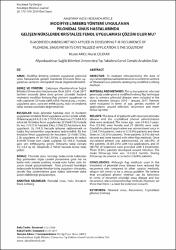MODİFİYE LİMBERG YÖNTEMİ UYGULANAN PİLONİDAL SİNÜS HASTALARINDA GELİŞEN NÜKSLERDE KRİSTALİZE FENOL UYGULAMASI ÇÖZÜM OLUR MU?
Özet
AMAÇ: Modifiye limberg yöntemi uygulanan pilonidal sinüs hastalarında gelişen nükslerde kristalize fenol uygulaması verilerini retrospektif olarak değerlendirmektir. GEREÇ VE YÖNTEM: Çalışmaya Afyonkarahisar Sağlık Bilimleri Üniversitesi Hastanesine Ocak 2016 - Ocak 2017 tarihleri arasında daha önce primer pilonidal hastalık nedeniyle modifiye limberg ?ep yöntemi uygulanan ve nüks saptanan 32 hasta dahil edildi. Hastalar yaş, cinsiyet, uygulama sayısı, yara yeri enfeksiyonu, nüks ve ortalama takip zamanı açısından değerlendirildi. BULGULAR: Nüks pilonidal hastalığı olan 32 hastanın uygulanan kristalize fenol uygulama verileri analiz edildi. Ortalama yaş 24.4±5.3 idi. 5 (% 15.6)’i kadın ve 27 (% 84.4)’si erkek idi. Kristalize fenol uygulaması 22 (%68.75) hastada bir kez, 5 (%15.6) hastada 2 kez, 2 (%6.25) hastada üç kez uygulandı. Üç (%9.3) hastada iyileşme sağlanamadı ve başka ?ep yöntemleri uygulanarak tedavi edildi. Bir kez kristalize fenol uygulaması ile hastaların 22 (%68.75)’ini, 2 İki uygulama ile 26 (%81.25)’ini, 3 uygulama ile tedavi 31(%90.7)’inde tam olarak sağlandı. Üç (%9.3) hastada yara yeri enfeksiyonu gelişti. Ortalama takip zamanı 13.1±6.4 ay idi. Takiplerde 2 (%6.8) hastada tekrar nüks gelişti. SONUÇ: Pilonidal sinüs hastalığı tedavisinde kullanılan ?ep yöntemleri diğer cerrahi yöntemlere göre her ne kadar nüks oranını azaltmış olsada nüks halen ciddi bir sorun olarak gözükmektedir. Nüks pilonidal hastalığın tedavisinde kristalize fenolün kolay uygulanır olmasının, cerrahi ?ep yöntemlerine göre nüksü önlemede daha üstün olabileceği görüşündeyiz. OBJECTIVE: To evaluate retrospectively the data of crystallized phenol administration in recurrent recurrence of Pilonidal sinus patients undergoing modified Limberg method. MATERIAL AND METHODS: Thirty-two patients who had previously undergone a modified limberg ?ap technique due to primary pilonidal disease were included in the study between January 2016 - January 2017. Patients were evaluated in terms of age, gender, number of applications, wound infection, recurrence and mean follow-up time. RESULTS: The data of 32 patients with recurrent pilonidal disease and the crystallized phenol administration data were analyzed. The mean age was 24.4±5.3 years. Five (15.6%) were female and 27 (84.4%) were male. Crystalline phenol application was administered once in 22 (68.75%) patients, twice in 5 (15.6%) patients and three times in 2 (6.25%) patients. Three patients (9.3%) did not recover and were treated with other ?ap methods. Once crystallized phenol was administered, 22 (68.75%) of the patients, 26 (81.25%) with two applications, and 31 (90.7%) of treatment were provided with 3 treatments. Three (9.3%) patients developed wound infection. The mean follow-up time was 13.1±6.4 months. During follow-up, recurrence occurred in 2 (6.8%) patients. CONCLUSIONS: Although ?ap methods used in the treatment of pilonidal sinus disease have reduced the recurrence rate compared to other surgical methods, relapse still seems to be a serious problem. We believe that crystallized phenol method can be beterness in terms of recurrent pilonidal sinus disease and low recurrence rates compared to ?ap methods. However, we think that there is a need for extensive research.
















